
Villa Clara is one of the provinces of Cuba. It is located in the central region of the island bordering on the Atlantic Ocean to the north, Matanzas Province to the west, Sancti Spiritus Province to the east, and Cienfuegos Province to the South. Villa Clara shares with Cienfuegos and Sancti Spiritus on the south the Escambray Mountain Range. Its main cities are Santa Clara, Remedios, Sagua La Grande, Camajuani, Caibarién, Ranchuelo, Placetas, and Manicaragua.

Cienfuegos, capital of Cienfuegos Province, is a city on the southern coast of Cuba. It is located about 250 km (160 mi) from Havana and has a population of 150,000. Since the late 1960s, Cienfuegos has become one of Cuba's main industrial centers, especially in the energy and sugar sectors. The city is dubbed La Perla del Sur. Although Cienfuegos literally translates to "one hundred fires", the city takes its name from the surname of José Cienfuegos, Captain General of Cuba (1816–19).

Santa Clara is the capital city of the Cuban province of Villa Clara. It is centrally located in the province and Cuba. Santa Clara is the fifth-most populous Cuban city, with a population of nearly 250,000.

Parque Vidal is a park located in the center of Santa Clara, Cuba, covering an entire square block of the city. Due to its surrounding architecture, combining eclectic neo-classical and colonial-style buildings, as well as the large number of historic monuments dating from different historical periods, the park was designated as a National Monument in a ceremony in 1998.

Cruces is a municipality and town in Cienfuegos Province, Cuba. It is the home of the Mal Tiempo National Park which commemorates a battle in the 1895 War of Independence.

Colón is a municipality and city in the Matanzas Province of Cuba. The municipality has an area of 547 km2 (211 sq mi) and a population of about 71,000. The city proper, with a population of about 44,000, is the third-largest of its province.

Parque de los Mártires is a park in Santa Clara, Cuba. It is a few blocks from Parque del Carmen in front of Santa Clara railway station.
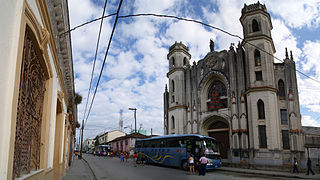
The Catedral de Santa Clara de Asís is a Roman Catholic cathedral located in the city of Santa Clara, Cuba. It lies on Calle Marta Abreu, one of the city's main arteries, only two blocks from Parque Vidal and next to the cultural centre "El Mejunje".
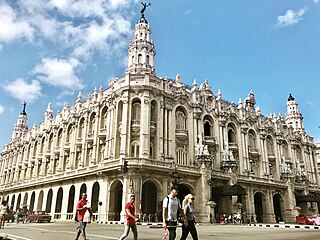
Gran Teatro de La Habana is a theater in Havana, Cuba, home to the Cuban National Ballet. It was designed by the Belgian architect Paul Belau and built by Purdy and Henderson, Engineers in 1914 at the site of the former Teatro Tacón. Its construction was paid for by the Galician immigrants of Havana to serve as a community-social center. Located in the Paseo del Prado, its facilities include theatres, a concert hall, conference rooms, a video screening room, as well as an art gallery, a choral center and several rehearsal halls for dance companies. It hosts the International Ballet Festival of Havana every two years since 1960.

Marta Abreu de Estévez was one of the most influential figures of her time in central Cuba, especially in her birth city and province of Santa Clara. For her constant aid to the poor, her donations to the city and the independence war, she won the title of "the great benefactor".

Paseo del Prado is a street and promenade in Havana, Cuba, near the location of the old city wall, and the division between Centro Habana and Old Havana. Technically, the Paseo del Prado includes the entire length of Paseo Martí approximately from the Malecon to Calle Máximo Gómez, the Fuente de la India fountain. The promenade has had several names; it was renamed Paseo de Martí in 1898 with the island's independence from Spain. Despite the historic references, the people of Havana simply call it "El Prado".

Santa Clara is the main railway station of the city of Santa Clara, seat of Villa Clara Province, Cuba. It is owned by the state company Ferrocarriles de Cuba (FFCC) and is located in front of Parque de los Mártires. It is one of the most important stations of Cuba and, along with Havana Central, Santiago and Camagüey, is a network's divisional headquarters.
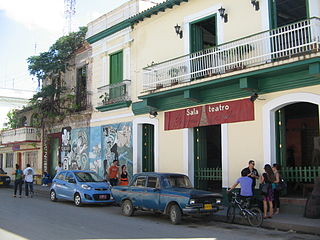
El Mejunje, also known as El Mejunje de Silverio after the surname of its founder and director, Ramón Silverio, is a Cuban LGBT cultural center and space located in the city of Santa Clara. It lies on the central Calle Marta Abreu, near the corner with Calle Juan Bruno Zayas, close to the Parque Vidal and La Caridad Theatre, next to the Saint Claire of Assisi Cathedral.
The following is a timeline of the history of the city of Cienfuegos, Cuba.
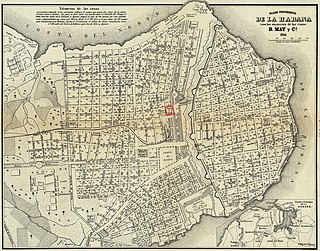
The Teatro Tacón opened in 1838 in Havana, Cuba. Its auditorium contained 2,750 seats. It was built by Pancho Martí, a businessman from Barcelona who moved to Havana, and named after Miguel Tacón y Rosique, Governor of Cuba from 1834 to 1838. In 1847 Bottesini's opera Cristoforo Colombo premiered there. By 1855, so many people attended events that the city issued parking regulations for carriages on performance nights.

The Parque Central, Havana is one of the best known and central sites of the city of Havana, Cuba. It is located between Prado, Neptuno, Zulueta and San José streets, and San Rafael Boulevard. Among the buildings surrounding the park are Gran Teatro de La Habana, the Hotel Inglaterra, the Hotel Telégrafo, el Hotel Parque Central, la Manzana de Gómez, the Hotel Plaza and Museo Nacional de Bellas Artes.

The Parque de la Fraternidad is a park in Havana, Cuba. It was built in the 1790s as a military practice range by the Spanish government; it was expanded in 1793 by Belgian engineer Agustin Cramer, and later the Bishop Espada improved the lighting of the Campo. It was Captain General Don Miguel Tacón who included it within the scope of his embellishment program. The area was then fenced and four majestic gates, crowned with coats of arms, each representing an important personality: the north gate, Hernán Cortés; the south one, Francisco Pizarro; and the east and west gates, Captain General Miguel Tacón y Rosique (1834-1838), and Christopher Columbus respectively.

Canoa or La Canoa is a small town in Villa Clara Province, Cuba, in the vicinity of the Sagua la Chica River. Nearby towns include Vega Alta, La Levisa, Chicharón, Paso Real, Santa Ana, La Doncella, and La Catalina. “Canoa” translates to “Canoe” in Spanish and shares the name with Arroyo La Canoa, a stream north of Canoa.
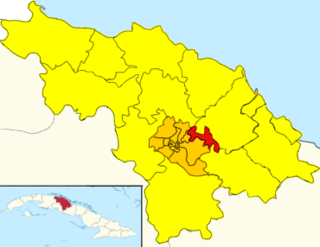
Camilo Cienfuegos also known as Callejón de Los Patos is a village and consejo popular in Santa Clara, Villa Clara, Cuba.
Miguel Tacón y Rosique, was a Spanish military and colonial administrator in the Spanish Americas. From 1834 to 1838, he was Governor of Cuba.






















